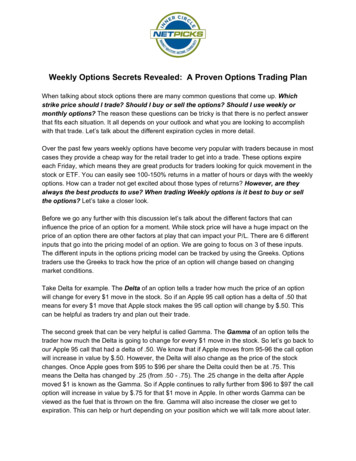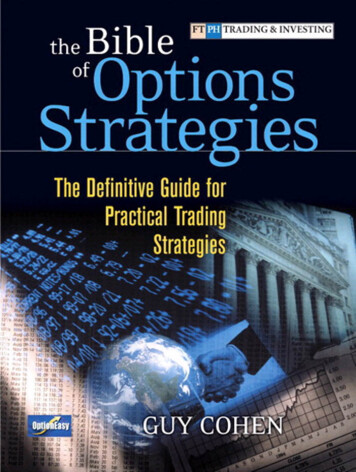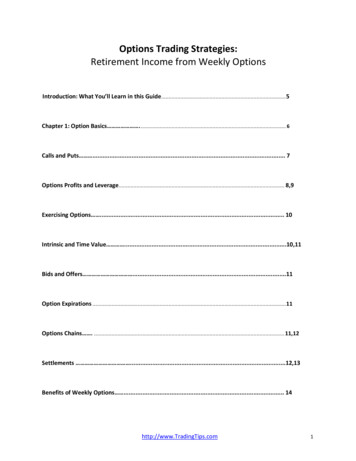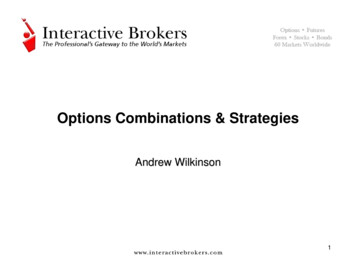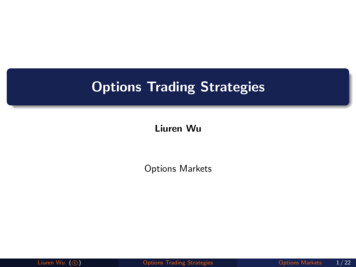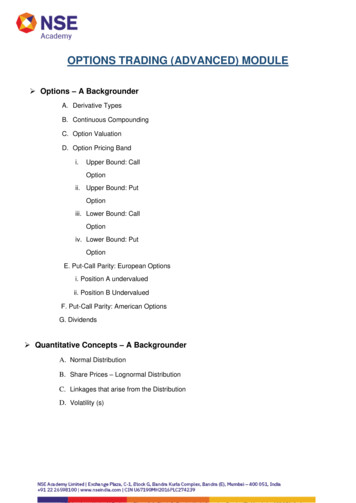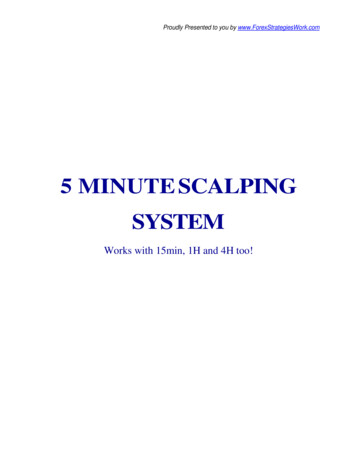
Transcription
ADVANCED OPTIONS STRATEGIESTHE OPTIONS PLAYBOOK SERIESByAn Online Stock and Options BrokerMember FINRA and SIPC
TABLE OF CONTENTSAdvanced Options StrategiesAre you ready to take your option trading to the next level? . 3Some assumptions . 3PLAY 1: Collar – Protection for (Nervous) Bulls . 4PLAY 2: Iron Condor – For a short-term neutral outlook . 6PLAY 3: Short Call Spread – For the bearish and income-hungry . 8PLAY 4: Long Straddle – Looking ahead to increased volatility and big stock moves . 10PLAY 5: Long Butterfly Spread with Puts – Short-term neutral, with a narrow sweet spot . . 12In conclusion . . 14Learn more at TradeKing.com . . 14Options transactions involve risks and are not suitable for all investors. Prior to entering into options transactions, an investor must read andunderstand Characteristics and Risks of Standardized Options. To receive a free copy, please visit TradeKing.com at http://www.tradeking.com/ODD,call 1.877.495.KING, or write to TradeKing, PO Box 49050 Charlotte, NC 28277-3432.Multiple leg options strategies involve additional risks and multiple commissions, and may result in complex tax treatments. Please consult a tax professional priorto implementing these strategies.Any strategies discussed and examples using actual securities and price data are for educational and illustrative purposes only and do not imply a recommendationor solicitation to buy or sell a particular security or to engage in any particular investment strategy. In reading content on TradeKing’s website or in this IntelligenceReport, you may gain ideas about when, where, and how to invest your money. Although you may discover new ideas or rationale that may be compelling, you mustultimately decide whether or not to put your own money at risk. Consider the following when making an investment decision: your financial and tax situation, your riskprofile, and transaction costs.COM PO Box 49050 Charlotte, NC 28277-3432 TEL 877.495.5464 (KING) FAX 866.699.0563 MEMBER FINRA & SIPC2
Are you ready to take your option trading to the next level?You already know the difference between puts and calls. And you’ve probably written a few covered calls,or dabbled in cash-secured put selling. So you already have a taste of how versatile options can be whenhedging risks, collecting income, and speculating on future price moves.The fact is, with a little learning and proper risk management, you can use options to potentially investprofitably in up, down, sideways and volatile markets. So get ready to load up your toolkit with five advancedoptions plays, with strategies you can use whether you’re bullish, bearish, neutral, or expecting increasedvolatility.Some assumptionsThis Intelligence Report assumes you are well-versed in basic options concepts (ITM, OTM, implied volatility,etc.) and have begun trading spreads. If you’re not as confident in your knowledge of these topics as you’d liketo be, find out more in the Learning Center at TradeKing.com.As a veteran options trader, you know implied volatility is important in all options trades. You also probablyknow its value is determined with an options pricing model. Why mention this again? We just want to be sureyou’re aware theoretical data and the market place don’t necessarily add up. So while implied volatility can behelpful in your decision making process, the inferences derived from it might not come to pass in the real world.The plays included here are “multiple leg options strategies”; each play has more than one trade, or leg. Keepin mind, these multi-leg plays have more risks and also more commissions. They may also have complex taximplications, so be sure to speak to a tax professional in advance.And finally, after every play, there’s a segment for checking your trade with TradeKing’s tools. Although thesetools might give you a glimpse into the future about how your strategy might play out, the projections theyprovide are hypothetical. Tools may help you analyze information, but they don’t give real investment results norpromise how things would be in the actual market place. Remember, you alone make the final determination ofwhether to pull the trigger. Consider your financial situation, risk tolerance and costs before trading.COM PO Box 49050 Charlotte, NC 28277-3432 TEL 877.495.5464 (KING) FAX 866.699.0563 MEMBER FINRA & SIPC3
P L AY O N ECOLLARYou can think of a collar as simultaneously running aprotective put and a covered call. Some investorsthink this is a sexy trade because the covered callhelps to pay for the protective put. So you’ve limited the downside on the stock for less than it wouldcost to buy a put alone, but there’s a tradeoff.The call you sell caps the upside. If the stock hasexceeded strike B by expiration, it will most likelybe called away. So you must be willing to sellit at that price.OPTIONS GUY’S TIPS:Many investors will run a collar when they’ve seen a nice run-upon the stock price, and they want to protect their unrealized profitsagainst a downturn.Some investors will try to sell the call with enough premium to payfor the put entirely. If established for net-zero cost, it is often referred toas a “zero-cost collar.” It may even be established for a net credit, ifthe call with strike price B is worth more than the put with strike priceA.NOTE: This graph indicates profit and loss at expiration, respective to thestock value when you sold the call and bought the put.THE SETUP You own the stock Buy a put, strike price A Sell a call, strike price B Generally, the stock price will be betweenstrikes A and BNOTE: Both options have the same expiration month.WHO SHOULD RUN ITRookies or higherSome investors will establish this play in a single trade. For every100 shares they buy, they’ll sell one out-of-the-money call contract andbuy one out-of-the-money put contract. This limits your downside riskinstantly, but of course, it also limits your upside.BREAK-EVEN AT EXPIRATIONFrom the point the collar is established, there aretwo break-even points: If established for a net credit, the break-even iscurrent stock price minus net credit received. If established for a net debit, the break-even iscurrent stock price plus the net debit paid.THE SWEET SPOTWHEN TO RUN ITYou’re bullish but nervous.You want the stock price to be above strike B atexpiration and have the stock called away.MAXIMUM POTENTIAL PROFITTHE STRATEGYBuying the put gives you the right to sell the stock atstrike price A. Because you’ve also sold the call, you’llbe obligated to sell the stock at strike price B if theoption is assigned.From the point the collar is established, potentialprofit is limited to strike B minus current stockprice minus the net debit paid, or plus net creditreceived.MAXIMUM POTENTIAL LOSSFrom the point the collar is established, risk islimited to the current stock price minus strike A plusthe net debit paid, or minus the netcredit received.COM PO Box 49050 Charlotte, NC 28277-3432 TEL 877.495.5464 (KING) FAX 866.699.0563 MEMBER FINRA & SIPC4
TRADEKING MARGIN REQUIREMENTBecause you own the stock, the call you sold isconsidered “covered.” So no additional margin isrequired after the trade is established.AS TIME GOES BYFor this play, the net effect of time decay is somewhatneutral. It will erode the value of the option you bought(bad) but it will also erode the value of the option yousold (good).IMPLIED VOLATILITYAfter the play is established, the net effect of anincrease in implied volatility is somewhat neutral. Theoption you sold will increase in value (bad), but itwill also increase the value of the option you bought(good).CHECK YOUR PLAY WITH TRADEKING TOOLS Use the Profit Loss Calculator to establish breakeven points, evaluate how your strategy might changeas expiration approaches, and analyze the Greeks.COM PO Box 49050 Charlotte, NC 28277-3432 TEL 877.495.5464 (KING) FAX 866.699.0563 MEMBER FINRA & SIPC5
P L AY T WOIRON CONDORThe distance between strikes A and B is usuallythe same as the distance between strikes C andD. However, the distance between strikes B and Cmay vary to give you a wider sweet spot(see Options Guy’s Tip).You want the stock price to end up somewherebetween strike B and strike C at expiration. An ironcondor spread has a wider sweet spot than an ironbutterfly. But (as always) there’s a tradeoff. In thiscase, your potential profit is lower.OPTIONS GUY’S TIPS:One advantage of this strategy is that you want all of theoptions to expire worthless. If that happens, you won’t have to payany commissions to get out of your position.You may wish to consider ensuring that strike B and strike C arearound one standard deviation or more away from the stock price atinitiation. That will increase your probability of success. However, thefurther these strike prices are from the current stock price, the lower thepotential profit will be from this play.THE SETUP Buy a put, strike price A Sell a put, strike price B Sell a call, strike price C Buy a call, strike price D Generally, the stock will be between strike price Band strike price CNOTE: All options have the same expiration month.As a general rule of thumb, you may wish to consider running thisplay approximately 30–45 days from expiration to take advantage ofaccelerating time decay as expiration approaches. Of course, thisdepends on the underlying stock and market conditions such as impliedvolatility.Some investors may wish to run this play using index optionsrather than options on individual stocks. That’s because historically,indexes have not been as volatile as individual stocks. Fluctuations inan index’s component stock prices tend to cancel one another out,lessening the volatility of the index as a whole.WHO SHOULD RUN ITVeterans and higherBREAK-EVEN AT EXPIRATIONWHEN TO RUN ITYou’re anticipating minimal movement on thestock within a specific time frame.THE STRATEGYYou can think of this play as simultaneously running anout-of-the-money short put spread and an out-of-the-money short call spread. Some investors consider this to bea more attractive strategy than a long condor spreadwith calls or puts because you receive a net credit intoyour account right off the bat.Typically, the stock will be halfway between strike Band strike C when you construct your spread. If the stockis not in the center at initiation, the play will be eitherbullish or bearish.There are two break-even points: Strike B minus the net credit received Strike C plus the net credit receivedTHE SWEET SPOTYou achieve maximum profit if the stock price isbetween strike B and strike C at expiration.MAXIMUM POTENTIAL PROFITProfit is limited to the net credit received.MAXIMUM POTENTIAL LOSSRisk is limited to strike B minus strike A, minus thenet credit received.COM PO Box 49050 Charlotte, NC 28277-3432 TEL 877.495.5464 (KING) FAX 866.699.0563 MEMBER FINRA & SIPC6
TRADEKING MARGIN REQUIREMENTThe greater of the short call spread requirement (thedifference between the call strike prices) or the short putspread requirement (the difference between the put strikeprices).NOTE: The net credit received from establishing the iron condor may be applied to the initial margin requirement.Keep in mind this requirement is on a per-unit basis. So don’t forget to multiplyby the total number of units when you’re doing the math.AS TIME GOES BYFor this play, time decay is your friend. You want allfour options to expire worthless.IMPLIED VOLATILITYAfter the play is established, the effect of impliedvolatility depends on where the stock is relative to yourstrike prices.If the stock is near or between strikes B and C, youwant volatility to decrease. This will decrease the valueof all of the options, and ideally, you’d like the ironcondor to expire worthless. In addition, you want thestock price to remain stable, and a decrease in impliedvolatility suggests that may be the case.If the stock price is approaching or outside strike A orD, in general you want volatility to increase. Anincrease in volatility will increase the value of theoption you own at the near-the-money strike, whilehaving less effect on the short options at strikes B andC. So the overall value of the iron condor willdecrease, making it less expensive to close yourposition.CHECK YOUR PLAY WITH TRADEKING TOOLS Use the Profit Loss Calculator to establish breakeven points, evaluate how your strategy might changeas expiration approaches, and analyze the Greeks. Use the Probability Calculator to verify that strikes Band strike C are about one standard deviation awayfrom the stock price.COM PO Box 49050 Charlotte, NC 28277-3432 TEL 877.495.5464 (KING) FAX 866.699.0563 MEMBER FINRA & SIPC7
P L AY T H R E ESHORT CALLSPREADAKA Bear Call Spread; Vertical SpreadA short call spread is an alternative to the shortcall. In addition to selling a call with strike A,you’re buying the cheaper call with strike B to limityour risk if the stock goes up. But there’s a tradeoff— buying the call also reduces the net creditreceived when running the strategy.OPTIONS GUY’S TIPS:One advantage of this strategy is that you want both options toexpire worthless. If that happens, you won’t have to pay any commissions to get out of your position.You may wish to consider ensuring th
ADVANCED OPTIONS STRATEGIES THE OPTIONS PLAYBOOK SERIES Member FINRA and SIPC An Online Stock and Options Broker By.COM PO Box 49050 Charlotte, NC 28277-3432 TEL 877.495.5464 (KING) FAX 866.699.0563 MEMBER FINRA & SIPC 2 TABLE OF CONTENTS Advanced Options Strategies Are you ready to take your option trading to the next level? . 3 Some

